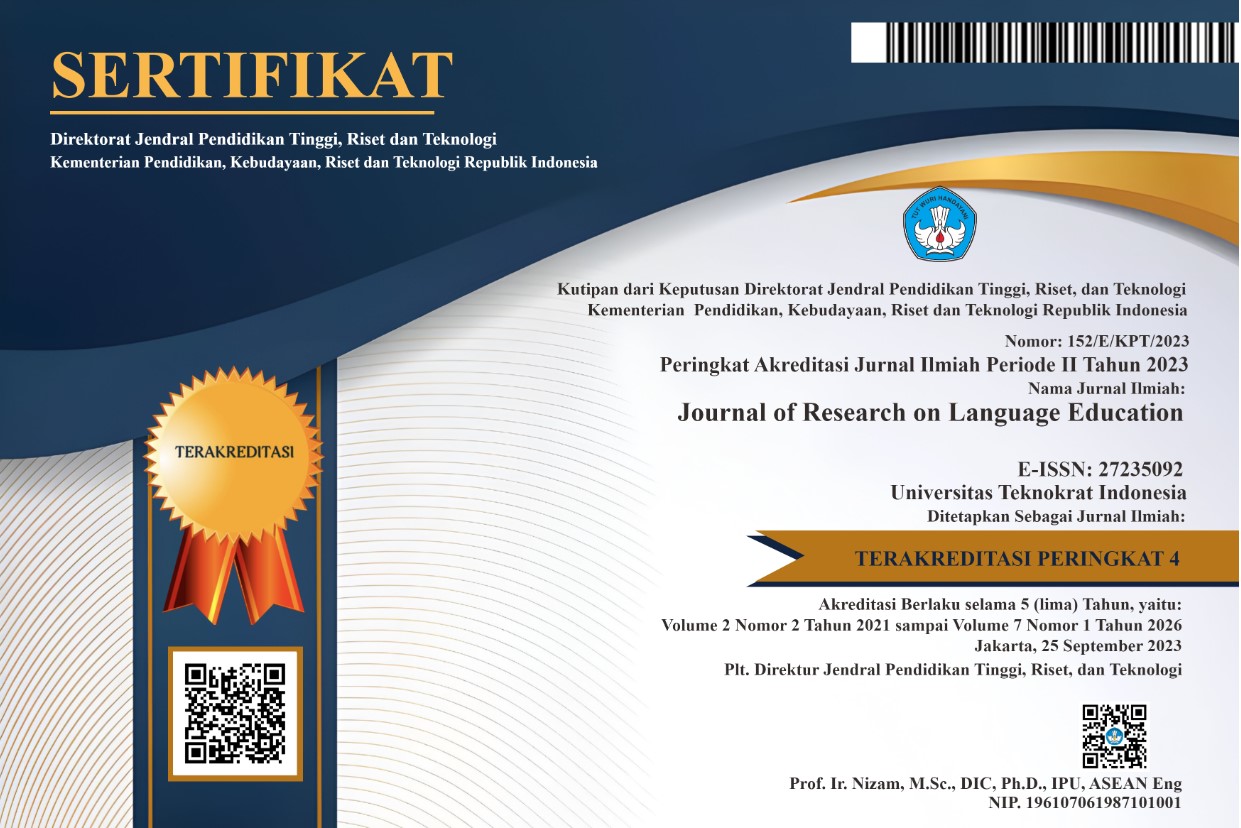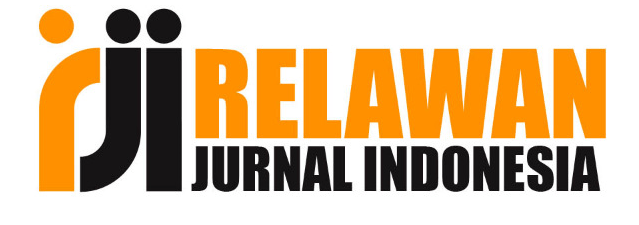ENHANCING READING FLUENCY AND COMPREHENSION IN ORAL READING THROUGH READING THEATRE
Abstract
Comprehension is the key of success reading. Researchers have shown that reading comprehension is improved when fluency increased. In order to construct the meaning of the text, instructional strategy which helps English language learners decode word until they fluently read and understand must be applied. This paper focuses on discussing the effects of using Readers Theatre as strategy to enhance English language learners fluency and comprehension in oral reading. It also provides the overview of the use of repeated reading. Readers Theater in particular, the role of fluency and comprehension in reading and the correlation about how fluency influences reading comprehension.
Keywords
Full Text:
PDFReferences
Aminatun, D., Ngadiso, N., & Marmanto, S. (2019). Applying PLEASE strategy to teach writing skill on students with different linguistic intelligence. Teknosastik, 16(1), 34-40.
Ayu, M. (2019). Interactive activities for effective learning in overcrowded classrooms. Linguists: Journal of Linguistics and Language Teaching, 4(2), 1-6.
Ayu, M., Diem, C. D., & Vianty, M. (2017). Secondary school students’ English literacy: Use of interactive read aloud instructional strategy. International Journal of Applied Linguistics and English Literature, 6(7), 292-299
Black, L. A. (2016). The effects of reader's theater on reading comprehension and fluency of fifth-grade students. Walden Dissertations and Doctoral Studies Collection
Bogan, B. L., King-Mckenzie, E., & Bantwini, B. D. (2012). Bogan Differentiated Instruction Model. US-China Education Review A, 12, 1548–6613
Coger, L. I. (1963). Theatre for oral interpreters. Speech Teacher, 12, 322–330. Retrieved from http://www.tandfonline.com/toc/rced19/12/4
Duchovičová, J., Kozárová, N., Kurajda, L., Bajrami, B., & Baghana, J. (2019). Level of auditory analysis, synthesis and active vocabulary and their intergender context. XLinguae, 12(4), 229–238. https://doi.org/10.18355/XL.2019.12.04.20
Duncan, L. G., Mcgeown, S. P., Griffiths, Y. M., Stothard, S. E., & Dobai, A. (2016). Adolescent reading skill and engagement with digital and traditional literacies as predictors of reading comprehension. British Journal of Psychology, 107(2), 209–238. https://doi.org/10.1111/bjop.12134
Dowhower, S. L. (1989). Repeated reading: Research into practice. The Reading Teacher, 42(7), 502-507. Retrieved from http://www.jstor.org/stable/20200198
Hertzberg, M. (2000). ‘So we can learn something as well as doing something fun’: Learning about reading through readers’ theatre. Australian Journal of Language and Literacy. Retrieved from https://www.questia.com/library/journal/1G1-66886468/so-we-can-learn-something-as-well-as-doing-something
Hoffman, J. V., & Isaacs, M. E. (1991). Developing fluency through restructuring the task of guided oral reading. Theory into Practice, 30(3), 185-194.
Hudson, R. F., Lane, H. B., & Pullen, P. C. (2005). Reading fluency assessment and instruction: What, why, and how?. The Reading Teacher, 58(8), 702-714. Retrieved from http://www.fcrr.org/publications/publicationspdffiles/hudson_lane_pullen_readingfluency_2005.pdf
Kocaarslan, M. (2016). An exploratory study of the relationships between reading comprehension competence, reading attitude and the vividness of mental imagery among Turkish fourth-grade students. International Electronic Journal of Elementary Education, 8(4), 675–686.
Kuhn, M. R., & Stahl, S. A. (2000). Fluency: A review of developmental and remedial practices. Ann Arbor, MI: Center for the Improvement of Early Reading Achievement.
LaBerge, D., & Samuels, S. J. (1974). Toward a theory of automatic information processing in reading. Cognitive Psychology, 6, 293-323.
Martinez, M., Roser, N. L. & Strecker, S. (1998). I never thought I could be a star: A Readers Theatre ticket to fluency. The Reading Teacher, 52, 326–334. Retrieved from, http://www-tc.pbs.org/teacherline/courses/rdla150/docs/c1s3_11ineverthought.pdf
National Reading Panel. (2000). Teaching children to read: An evidence-based assessment of the scientific research literature on reading and its implications for reading instruction. Retrieved from https://www.nichd.nih.gov/publications/pubs/nrp/documents/report.pdf
Racmatia, M. (2016). Reader’s theater: a solution to improve reading fluency and reading comprehension achievements of EFL students. Proceeded to Sriwijaya University Language Education International Conference.
Rasinski, T. V. (2003). The fluent reader: Oral reading strategies for building word recognition, fluency, and comprehension. New York: Scholastic.
Rasinski, T. V. (2010). The fluent reader: Oral and silent reading strategies for building word recognition, fluency, and comprehension (2nd ed.). New York: Scholastic
Reutzel, R. D., & Cooter, R. B. (2011). Strategies for reading assessment and instruction: Helping every child succeed (4th ed.). Boston, MA: Pearson.
Rowen, D., Biggs, D., Watkins, N., & Rasinski, T. (2015). Choral reading theater: Bridging accuracy, automaticity, and prosody in reading fluency across an academic unit of study. Journal of Teacher Action Research, 1, 53-69.
Samuels, S. J. (1997). The method of repeated readings. The Reading Teacher, 50(5), 376-381.
Tarchi, C. (2017). Comprehending Expository Texts: The Role of Cognitive and Motivational Factors. Reading Psychology, 38(2), 154–181. https://doi.org/10.1080/02702711.2016.1245229
Tyher, B. (2010). The Handbook of Social Work Research Methods, Florida: SAGE Publication
Vasinda, S., & McLeod, J. (2011). Extending readers theatre: A powerful and purposeful match with podcasting. The Reading Teacher, 64(7), 486-497. Retrieved from http://onlinelibrary.wiley. com/doi/10.1598/RT.64.7.2/abstract
Yavuz Mumcu, H., & Aktürk, T. (2017). An Analysis of the Reasoning Skills of Pre-Service Teachers in the Context of Mathematical Thinking. Online Submission, 3(5), 225–254. https://doi.org/10.5281/zenodo.495700
DOI: https://doi.org/10.33365/jorle.v2i2.1107
Refbacks
- There are currently no refbacks.

This work is licensed under a Creative Commons Attribution-NonCommercial-ShareAlike 4.0 International License.

Articles published in Journal of Research on Language Education is licensed
under a Creative Commons Attribution-ShareAlike 4.0 International License.
English Education Study Program, Faculty of Arts and Education.
Universitas Teknokrat Indonesia
Zainal Abidin Pagaralam 9-11 Bandar Lampung, Indonesia
All rights reserved.








